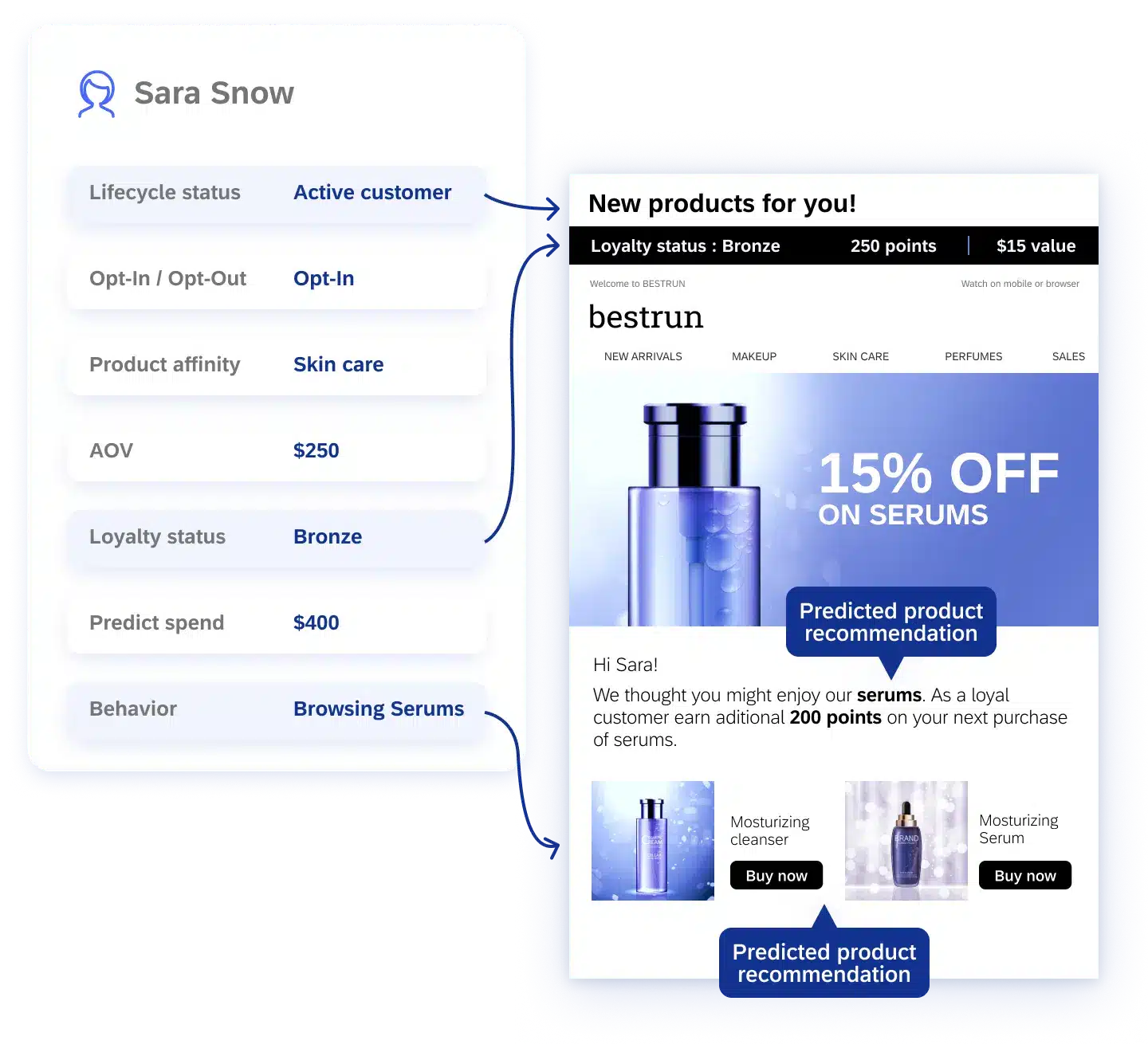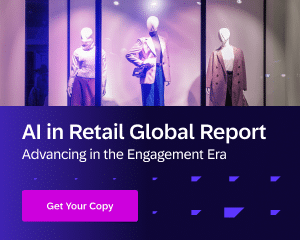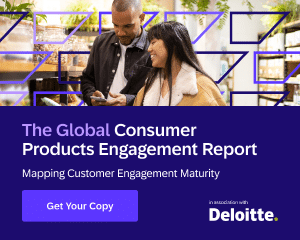Imagine you’re leading a global retail brand with tens of thousands of customers interacting across social media, in-store kiosks, mobile apps, and your eCommerce site.
You already use a Customer Relationship Management (CRM) system to track sales leads and store contact information. However, you’re finding that it lacks the real-time, dynamic features needed to deliver personalized campaigns at scale.
Meanwhile, your marketing team struggles to coordinate promotions across channels, and your loyalty efforts don’t feel “connected.” That’s where a Customer Engagement Platform (CEP) can step in, complementing or even redefining your CRM-driven approaches.
As market dynamics shift toward AI-driven omnichannel experiences, it’s crucial to determine whether a traditional CRM alone suffices or if the advanced capabilities of a CEP would better serve your enterprise.
This guide highlights those distinctions and explores advanced CEP use cases that deliver transformative results for enterprise teams. Let’s dive in.
CEP: Driving Real-Time, AI-Powered Omnichannel Engagement
A Customer Engagement Platform (CEP) focuses on enhancing customer interactions using data-driven personalization across channels. By unifying multiple data sources, CEPs empower targeted and relevant communications that elevate loyalty and boost revenue. Modern CEPs can deliver:
- Real-time engagement: Trigger personalized messaging based on user actions, lifecycle stage, and preferences.
- AI-driven omnichannel marketing campaigns: Orchestrate consistent experiences seamlessly transitioning between email, social, mobile apps, and brick-and-mortar stores.
For instance, PharmaPets chose SAP Emarsys to manage its CEP and personalize customer interactions, underscoring how brands now see AI-driven personalization as essential rather than optional.
Check out: AI-driven customer engagement platform to learn how real-time orchestration can amplify campaigns.

CRM: Foundational Data and Sales Management
A Customer Relationship Management (CRM) system is typically the single source of contact data, focusing on sales pipelines, lead tracking, and basic historical customer insights.
While CRMs can be crucial for managing sales funnels, they often lack robust real-time engagement features.
Notable advantages include:
- Streamlined sales processes: Track leads through every stage of the funnel.
- Historical data: Identify patterns in past transactions or interactions.
- Basic segmentation: Create broad groupings of customers for mass outreach.
Key limitations:
- Limited personalization beyond generic grouping.
- No real-time response to evolving customer behavior.
- Incomplete omnichannel coverage for orchestrating complex journeys.
CEP vs. CRM: Why it Matters
CEPs expand beyond standard CRMs by providing real-time engagement and orchestrating complex customer journeys. They respond to user behavior—like browsing certain products or abandoning a cart—by sending contextually relevant messages at the right moment. This is increasingly important as customers expect hyper-personalized experiences across channels and devices.
CEPs are emerging as a crucial part of the martech stack, complementing CRM capabilities by infusing them with real-time data, AI-based personalization, and robust automation. By uniting both solutions, enterprises gain:
- Comprehensive customer views: Merge CRM’s historical records with CEP’s real-time tracking.
- Predictive marketing: Lean on AI to forecast user intent, product interest, and optimal send times.
- Greater lifetime value: Delivering timely, relevant experiences fosters loyalty and repeat purchases.
The State of Customer Engagement and CRM Industry
CRM systems have historically fueled improved customer relationships, streamlined lead management, and centralized data storage.
Emerging trends in customer engagement are transforming the industry. AI-driven personalization empowers businesses to deliver targeted content and recommendations based on individual preferences and behaviors. More insights include:
- According to Statista studies, the global CRM market is projected to grow by 10.17% between 2025 and 2029, reaching $145.60 billion in volume. These stats prove CRMs remain vital, yet they often can’t address the evolving need for real-time personalization.
- According to SAP Emarsys research, almost three-quarters of U.S. marketers increased their investment in AI in 2024.
- McKinsey data shows that 76% of customers prefer brands that personalize their services, and they are 78% more likely to make repeat purchases.
- Loyal, engaged customers also spend more—IBM found robust personalization can raise average revenue per user by 166%.
These trends underscore why advanced, AI-driven solutions, such as a CEP, are quickly becoming non-negotiable for enterprise-level marketers.
Additionally, omnichannel strategies ensure a seamless, consistent experience across various touchpoints, from email and social media to mobile apps and in-store interactions.
Case in Point: The Omnichannel Difference 2024: “Understanding challenges and opportunities for growth with omnichannel customer engagement” reveals how advanced data strategies and AI are reshaping consumer expectations.
Learn more with our guide on 7 ways brands power omnichannel strategies with customer data.
CEP Strategies: Driving Measurable Customer Engagement
To thrive in the market, businesses must employ effective strategies for customer engagement and CRM. Leveraging the right tools and approaches allows companies to build stronger customer relationships and drive long-term growth.
AI-driven automation
One key strategy is to utilize AI-driven automation to personalize customer interactions at scale. With vast customer data available, AI algorithms analyze patterns and preferences to deliver highly targeted content and recommendations.
Automation tools ensure these personalized experiences are delivered consistently across multiple channels, from email to social media to mobile apps. Tailoring each interaction to the individual fosters a more profound sense of customer connection and loyalty.
AI-driven Customer Data solutions automate hyper-personalization at scale. You can use AI to enrich your customer data.

Silo-busting collaboration
Another critical strategy is breaking down silos between marketing and merchandising teams, enabling seamless collaboration in response to consumer trends. Sharing data and insights in real-time allows these teams to quickly identify shifts in customer behavior and adapt their strategies accordingly.
For example, if a particular product or category surges in popularity, marketing can create targeted campaigns to capitalize on that momentum while merchandising optimizes inventory levels to meet demand. This agile, collaborative approach helps businesses stay ahead and drive more revenue.
Dynamic recommendations
Finally, businesses should employ dynamic product recommendations to enhance the customer experience and drive incremental sales. By analyzing factors like browsing history, past purchases, and real-time behavior, recommendation engines surface highly relevant products that customers are more likely to purchase.
These personalized suggestions make the shopping experience more efficient and enjoyable, encouraging customers to discover new items they may not have considered otherwise. Product recommendations boost average order value and customer lifetime value when executed well.
CEPs are about sending personalized emails and orchestrating sophisticated customer journeys that drive revenue, loyalty, and advocacy. Here are advanced use cases demonstrating the transformative potential for enterprise businesses:
Pro tip: AI-based solutions from AI-Driven Omnichannel Marketing Campaigns unify these strategies for deeper personalization and faster ROI.
Use case: Dynamic Product Recommendations & Personalized Communications
Challenge: Increase sales in specific product categories by delivering highly relevant, personalized experiences.
CEP solution: Utilize first-party data and AI to deliver dynamic product recommendations through personalized communications.
Real-world example: Using Emarsys’ AI-driven customer engagement platform and their customer data, BrandAlley delivered highly relevant, personalized experiences that significantly boosted revenue growth in specific product categories.
By integrating machine learning algorithms and AI that analyze purchase history, browsing behavior, and real-time data, BrandAlley can deliver highly targeted product recommendations. BrandAlley boosted average basket value by 10% and reclaimed 24% of customers on the verge of defection.
“After making all the changes to our website communications and coming together to ensure that our product reflects that in messaging, it was such an amazing project. What was great last year is that 30% of the total revenue the business saw was actually from home and garden and home and outdoor categories, which is a 130% increase compared to the previous year."
Want to learn more about this collaboration? Hear their full story or check out BrandAlley: The Power of Brand Advocacy.
Use case: Omnichannel personalization & lifecycle engagement
Challenge: Scale digital expansion while delivering personalized experiences across multiple channels.
CEP solution: Implement an omnichannel solution to deliver personalized experiences across channels, including options like Mobile Wallet and automation programs that span the complete customer lifecycle.
Real-world example: Krispy Kreme collaborated with SAP Emarsys’ strategic services team to implement best practices and optimize its customer journey across channels. Tapping into a customer lifecycle management solution, they realized a 70% uplift in website clicks and a 53% lead boost.
Learn more: From Donuts to Data: Krispy Kreme’s Omnichannel Marketing Journey
Adopting CEP to Drive Next-Level Results
AI, personalization, and data-driven insights are reshaping the future of customer engagement. While CRMs remain essential for foundational data management, the real-time orchestration and advanced automation offered by CEPs can catapult marketing strategies and transform entire customer journeys.
By embracing these best practices and partnering with solutions like SAP Emarsys Customer Engagement Platform, you can future-proof your marketing approach—enabling you to deliver impactful, targeted experiences that grow revenue and strengthen loyalty in an ever-competitive market.
Remember, the difference between a standard CRM and a comprehensive CEP could decide how effectively you engage, convert, and retain customers over the long term.
By orchestrating AI-powered engagement across every touchpoint, you align your brand with evolving consumer expectations—and ultimately, set the stage for sustained success in 2025 and beyond.







